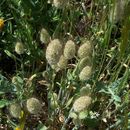Global Distribution
provided by Bibliotheca Alexandrina LifeDesk
Native to southwest Europe and the Mediterranean region, but widely introduced as an ornamental both for its horticultural value and for flower arrangements for which it is often dyed bright colours.
- author
- BA Cultnat
- provider
- Bibliotheca Alexandrina
Description
provided by eFloras
Tufted, greyish-pubescent annual; culms 8-50 cm high, erect or ascending, simple or branched from the lower nodes. Leaf-blades 1-20 cm long, 2-14 mm wide, velvety-pubescent; sheaths inflated. Panicle .0.5-6 cm long, 0.5-2 cm wide, very softly and densely hairy. Spikelets 7-9 mm long (excluding awns), those at the base of the panicle mostly sterile; glumes villous on the back, the setaceous tip with hairs c.2 mm long; lemma 3-5 mm long, lanceolate, bearing 2 apical bristles 2-6 mm long and a dorsal awn 8-20 mm long.
- license
- cc-by-nc-sa-3.0
- copyright
- Missouri Botanical Garden, 4344 Shaw Boulevard, St. Louis, MO, 63110 USA
Comprehensive Description
provided by North American Flora
Lagurus ovatus L. Sp. PI. 81. 1753
Culms slender, branching at base, pubescent, or sometimes nearly glabrous above, 10-30 cm. tall; sheaths pubescent, somewhat inflated; ligule thin, rounded, pubescent, erose, 2-3 mm. long; blades flat, lax, pubescent, mostly less than 10 cm. long, as much as 1 cm. wide, usually less; panicle pale, downy, bristling with dark awns, 2-3 cm. long, nearly as thick; glumes very narrow, 1 cm. long; lemma 3 mm. long, pilose below, the awn much exceeding the glumes.
Type locality: Southern Europe.
Distribution: Cultivated for ornament and sparingly escaped, California (Pacific Grove, San Francisco, Berkeley); ballast, Beaufort, North Carolina; Mediterranean region.
- bibliographic citation
- Albert Spear Hitchcock. 1937. (POALES); POACEAE (pars). North American flora. vol 17(7). New York Botanical Garden, New York, NY
Physical Description
provided by USDA PLANTS text
Annuals, Terrestrial, not aquatic, Stems nodes swollen or brittle, Stems erect or ascending, Stems geniculate, decumbent, or lax, sometimes rooting at nodes, Stems solitary, Stems caespitose, tufted, or clustered, Stems terete, round in cross section, or polygonal, Plants conspicuously hairy, grayish, or wooly, Stem internodes hollow, Stems with inflorescence less than 1 m tall, Stems, culms, or scapes exceeding basal leaves, Leaves mostly basal, below middle of stem, Leaves mostly cauline, Leaves conspicuously 2-ranked, distichous, Leaves sheathing at base, Leaf sheath mostly open, or loose, Leaf sheath hairy, hispid or prickly, Leaf sheath enlarged, inflated or dis tended, Leaf blades linear, Leaf blades 2-10 mm wide, Leaf blades 1-2 cm wide, Leaf blades mostly flat, Leaf blades more or less hairy, Ligule present, Ligule an unfringed eciliate membrane, Inflorescence terminal, Inflorescence a dense slender spike-like panicle or raceme, branches contracted, Inflorescence solitary, with 1 spike, fascicle, glomerule, head, or cluster per stem or culm, Inflorescence densely corymbose, paniculate, or capitate, rays reduced or absent, Inflorescence spike linear or cylindric, several times longer than wide, Inflorescence branches more than 10 to numerous, Flowers bisexual, Spikelets pedicellate, Spikelets laterally compressed, Spikelet less than 3 mm wide, Spikelets with 1 fertile floret, Spikelets solitary at rachis nodes, Spikelets all alike and fertille, Spikelets bisexual, Spikelets disarticulating above the glumes, glumes persistent, Spikelets disarticulating beneath or between the florets, Spikelets in dense head-like clusters, Rachill a or pedicel glabrous, Glumes present, empty bracts, Glumes 2 clearly present, Glumes equal or subequal, Glumes equal to or longer than adjacent lemma, Glume equal to or longer than spikelet, Glumes 1 nerved, Lemmas thin, chartaceous, hyaline, cartilaginous, or membranous, Lemma 5-7 nerved, Lemma body or surface hairy, Lemma apex dentate, 2-fid, Lemma distinctly awned, more than 2-3 mm, Lemma with 3 awns, Lemma awn less than 1 cm long, Lemma awn 1-2 cm long, Lemma awn subapical or dorsal, Lemma awn twisted, spirally coiled at base, like a corkscrew, Lemma awn once geniculate, bent once, Lemma margins thin, lying flat, Lemma straight, Callus or base of lemma evidently hairy, Callus hairs shorter than lemma, Palea present, well developed, Palea membranous, hyaline, Palea about equal to lemma, Palea 2 nerved or 2 keeled, Stamens 3, Styles 2-fid, deeply 2-branched, Stigmas 2, Fruit - caryopsis, Caryopsis ellipsoid, longitudinally grooved, hilum long-linear.

